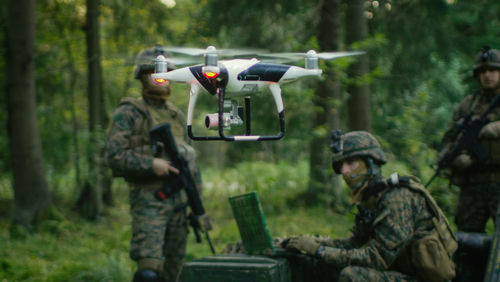The U.S. military’s recent attempt to showcase a “breakthrough” in drone warfare has only highlighted how far behind America is when it comes to modern combat innovation.
U.S. Military’s Drone Dilemma
The U.S. Army’s recent demonstration of grenade-dropping drones in Germany seemed more like an attempt to play catch-up than a cutting-edge display of military might. This so-called “breakthrough” was met with widespread criticism and mockery. The video of the event, meant to showcase American innovation, was quickly deleted after it drew comparisons to tactics that adversaries like ISIS pioneered nearly a decade ago. It’s a stark reminder of how far behind we’ve fallen in the global arms race.
While the Army’s public affairs office might have hoped for praise, what they got was a resounding “too little, too late” from military observers and experts. This misstep underscores a deeper issue within our defense framework: an inability to quickly adapt and incorporate low-cost, effective tactics that have been proven on battlefields worldwide. The failure to embrace such technologies isn’t just embarrassing; it’s potentially dangerous for our troops.
Learning from Ukraine’s Innovation
While the U.S. fumbled, Ukraine surged ahead, becoming a leader in drone warfare through necessity. Their conflict with Russia propelled them into developing and deploying drones for precision strikes. The Ukrainian forces have not only embraced this technology but have also turned it into a strategic advantage. They’ve demonstrated how homemade drones can be used effectively to strike deep into enemy territory, setting an example the U.S. should have been quick to follow.
The U.S. Army appears to have deleted a (widely mocked) tweet displaying its new grenade-dropping drone capability. pic.twitter.com/nw5Fuipy0I
— OSINTtechnical (@Osinttechnical) July 21, 2025
The U.S. has now turned to Ukraine, seeking to negotiate a $2.1 billion technology transfer deal. This agreement underscores the reality that our military innovation is reactive rather than proactive. It’s a bitter pill to swallow, knowing that the so-called world’s most advanced military has to rely on foreign innovation to keep pace with global threats.
Institutional Inertia and the Path Forward
The bureaucratic red tape that has hampered our military’s ability to modernize is a glaring issue. Despite the Pentagon’s recent announcement of reforms aimed at speeding up the procurement process, the fact remains that without significant changes, our forces will continue to lag. Secretary of Defense Pete Hegseth has acknowledged these systemic failures, but acknowledgement alone won’t solve the problem.
More coordinated drone swarms. This is what 1000 hive mind drones looks like.
Now imagine them even smaller, faster, and completely controlled by AI.
Conventional warfare is over. pic.twitter.com/UbJd1pCWqM
— Green Beret Nap Time (@GBNT1952) February 13, 2025
Military reform advocates have long pushed for a more agile and responsive acquisition process. However, institutional inertia remains a formidable barrier. The U.S. must learn from Ukraine’s rapid innovation cycles. Only by adopting a more flexible and responsive approach can we hope to regain our technological edge and ensure the safety and efficacy of our military operations.
Consequences of Falling Behind
The consequences of our technological lag are far-reaching. In the short term, U.S. forces may face increased risks on the battlefield. Without effective drone and counter-drone capabilities, our troops are at a disadvantage. Long-term implications are even more concerning. If we fail to modernize, we risk losing our battlefield supremacy to adversaries who embrace adaptable technologies.
The global defense industry is evolving, with an increased emphasis on low-cost, adaptable systems. For U.S. defense contractors, the challenge is clear: innovate or be left behind. The broader industry must recognize the urgency of this moment. Failing to do so could have dire consequences for national security.
Sources:
SOFX (Criticism of Army’s outdated tactics)
Defence-UA (Army deletes video, Ukraine’s role)
The War Zone (TWZ) (Comprehensive analysis of U.S. lag and global context)

